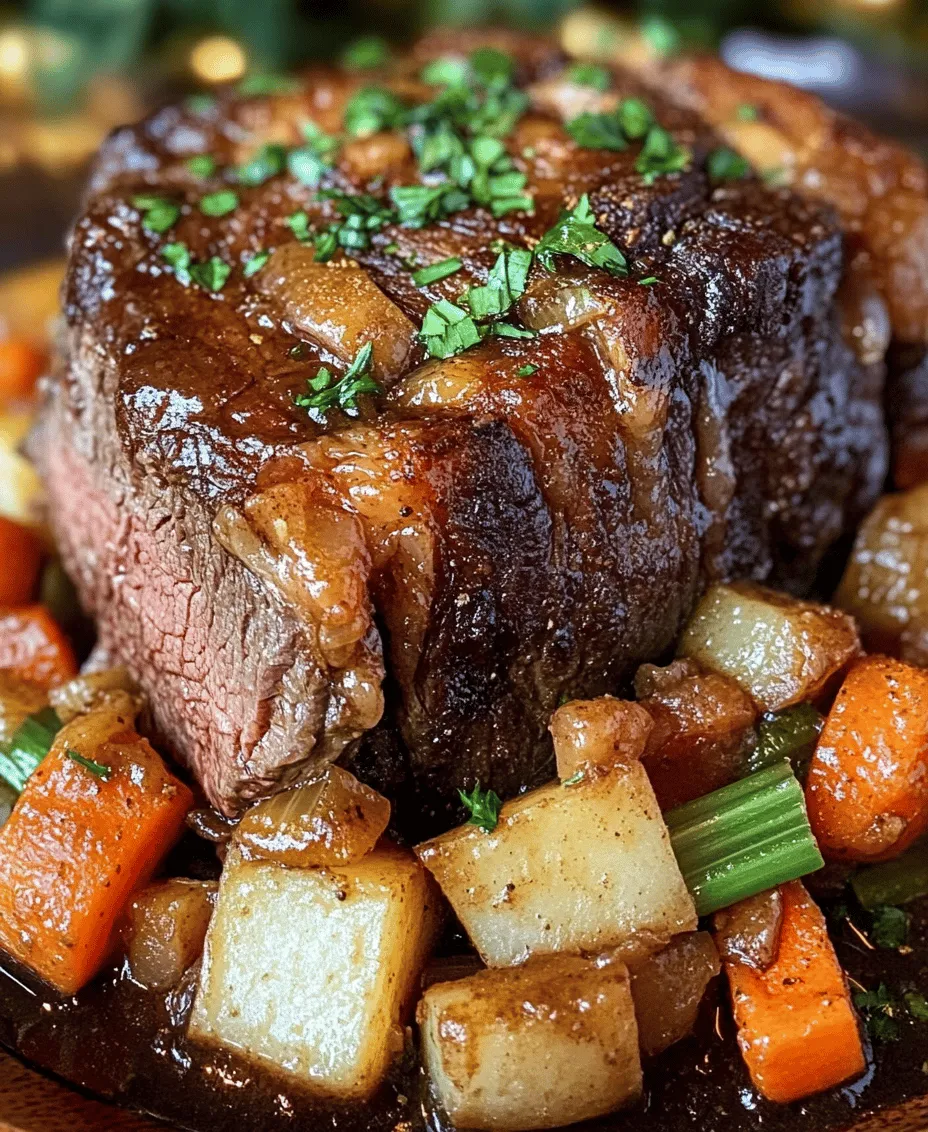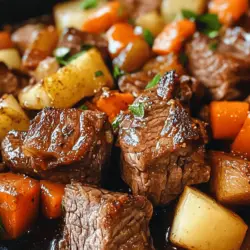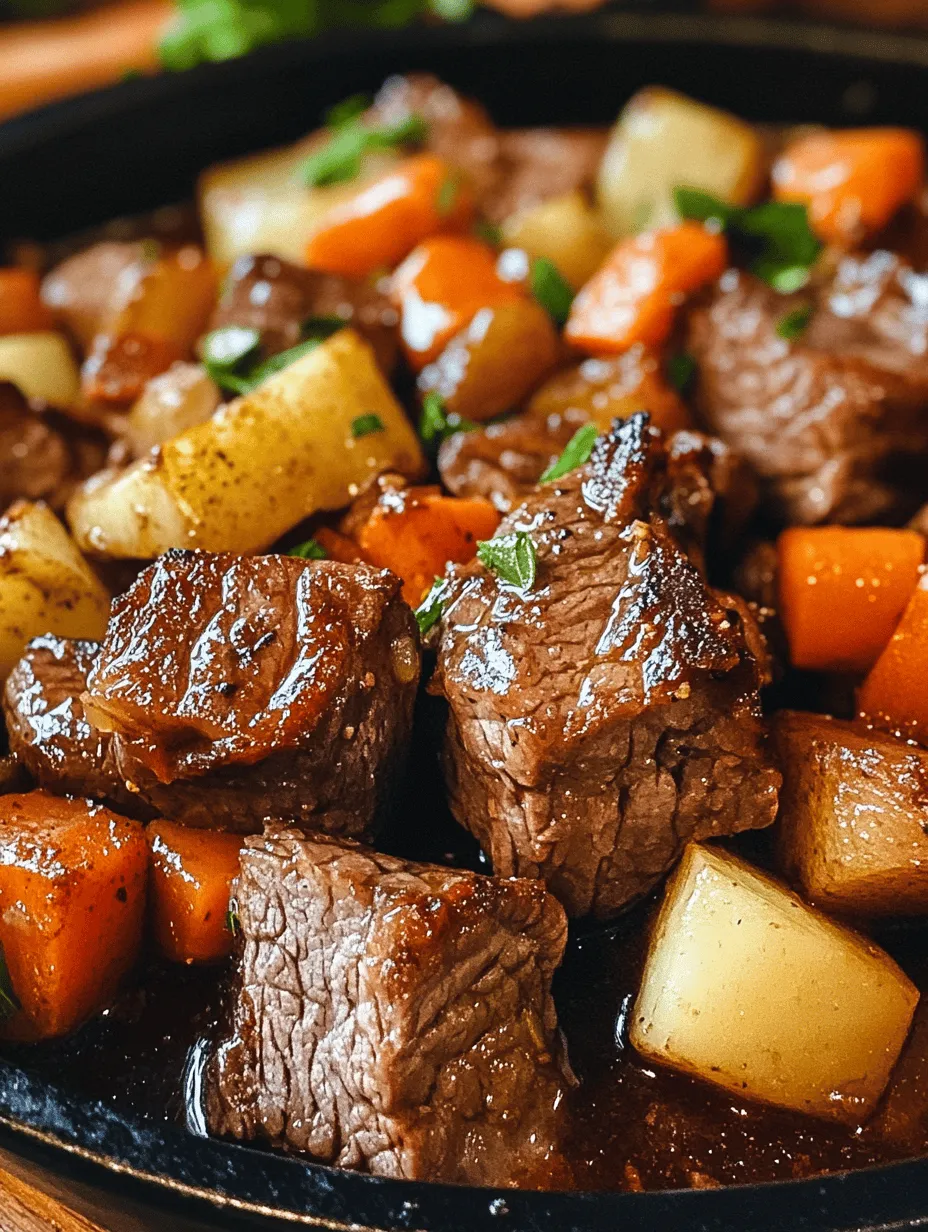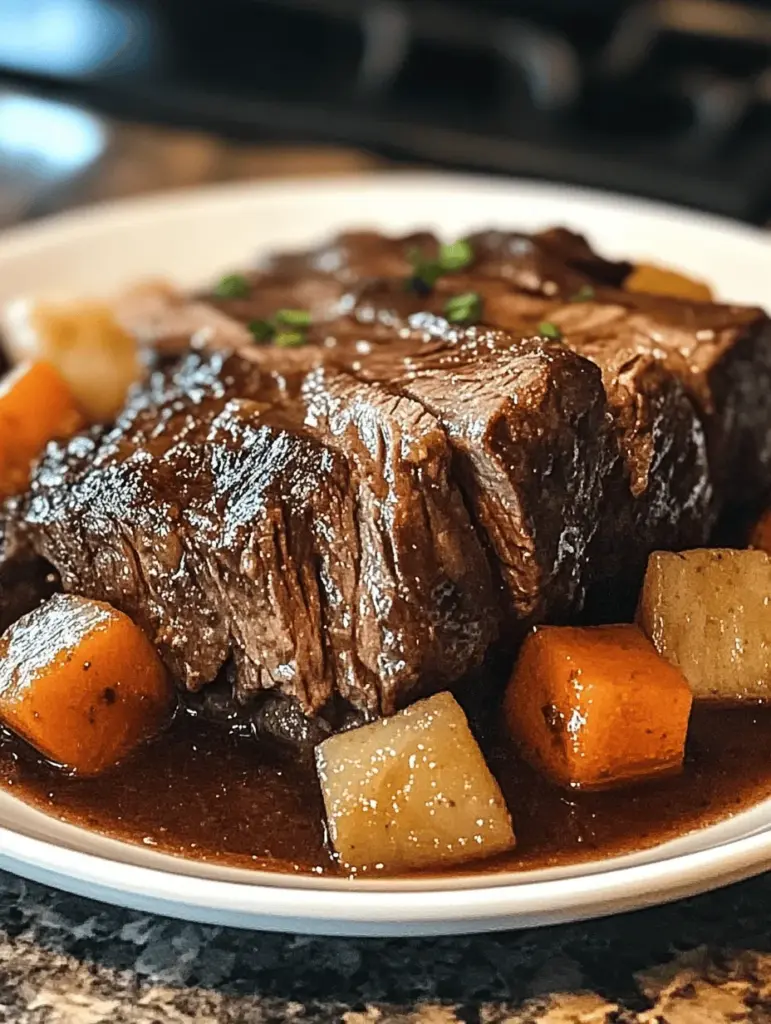Introduction
The warm and comforting embrace of a hearty old-fashioned pot roast is a culinary experience that evokes nostalgia and satisfaction. This timeless recipe is perfect for family gatherings or cozy dinners, bringing together tender beef, flavorful vegetables, and savory broth. The aroma of a pot roast simmering in the oven has a unique way of making a house feel like a home, enveloping everyone in a sense of comfort and warmth. In this article, we will explore the history and significance of pot roast, provide a detailed breakdown of the recipe, and share tips for achieving the perfect dish. Join us as we embark on a journey through the flavors and techniques that make this pot roast a beloved classic.
Understanding the Pot Roast Tradition
The Historical Significance of Pot Roast
Pot roast has deep roots in American culinary history, tracing back to the early settlers who needed to make the most out of their available resources. The dish emerged as a practical solution to turn tough cuts of meat into tender, succulent meals through slow cooking. Originally, pot roast involved a simple method of braising, where the meat is cooked slowly with moisture, allowing it to break down and become tender. This technique was passed down through generations, becoming a staple in many households.
As American cuisine evolved, so did the pot roast. Different regions adapted the recipe to incorporate local ingredients and flavors, leading to a variety of interpretations. In the Northeast, pot roast is often paired with hearty root vegetables like carrots and potatoes, while Southern variations may include a touch of spice or sweetness. These cultural adaptations highlight how pot roast has become a reflection of diverse culinary traditions across the country.
The Comfort Factor of Pot Roast
There’s a reason why pot roast is often labeled as comfort food: it’s synonymous with family gatherings, celebrations, and cherished memories. The act of preparing a pot roast is almost ritualistic; it involves careful selection of ingredients, methodical preparation, and the anticipation of a delicious meal that brings everyone together. It’s not just about the food; it’s about the experience of sharing a meal with loved ones.
Pot roast has an innate ability to evoke feelings of warmth and togetherness. It’s the dish that often graces the table during holidays and special occasions, creating a sense of unity and joy among family and friends. The combination of tender meat, flavorful broth, and seasonal vegetables creates a hearty meal that satisfies both hunger and the soul.
Ingredients Overview
Essential Ingredients for a Hearty Pot Roast
The heart of a successful pot roast lies in the quality of its ingredients. Here’s a detailed look at the essential components that contribute to a flavorful and satisfying dish:
- Beef Chuck Roast: The star of the show is undoubtedly the beef chuck roast. This cut is known for its rich flavor and marbling, which makes it ideal for slow cooking. When selecting a beef chuck roast, look for one that has good fat distribution, as this fat will render during cooking, keeping the meat moist and tender.
- Vegetables: Traditional pot roast typically includes a medley of vegetables such as carrots, potatoes, and onions. These vegetables not only add flavor but also absorb the delicious broth during the cooking process, enhancing their taste. Aim for a mix of colors and textures to create a visually appealing dish.
- Broth: A quality broth or stock forms the foundation of the pot roast’s flavor. Beef broth is commonly used, but homemade stock made from bones can elevate the dish even further. The broth adds moisture to the pot and infuses the meat and vegetables with rich, savory flavors.
- Seasonings: Simple seasonings like salt, pepper, garlic, and bay leaves are essential for enhancing the flavors of the pot roast. They work together to create a well-rounded taste that complements the beef and vegetables.
Optional Ingredients: Enhancing Flavor
While the essential ingredients provide a solid foundation, there are several optional ingredients that can enhance the flavor profile of your pot roast:
- Red Wine: Adding a splash of red wine can elevate the taste of your pot roast. The acidity in the wine helps to tenderize the meat while imparting a depth of flavor. A dry red wine, such as Cabernet Sauvignon or Merlot, works best for this purpose.
- Worcestershire Sauce: This classic condiment can add a layer of umami to your pot roast. A few dashes of Worcestershire sauce can enhance the beefy flavor and contribute to the overall richness of the dish.
- Alternative Ingredients: For those with dietary restrictions or preferences, there are various alternatives available. For instance, you can use vegetable broth for a vegetarian version or substitute root vegetables with seasonal produce like squash or parsnips.
Preparation Steps for Perfect Pot Roast
Preheat and Prepare
Before diving into the cooking process, it’s crucial to preheat your oven and prepare your ingredients. Preheating the oven ensures that your pot roast cooks evenly and thoroughly, allowing the flavors to develop beautifully. Set your oven to 325°F (163°C) and give it time to reach the desired temperature.
While the oven is heating, take a moment to prepare your beef roast. Remove it from the refrigerator and let it come to room temperature for about 30 minutes. This step is key to achieving a nice sear on the meat, as it allows for more even cooking. Season the beef generously with salt and pepper, ensuring that every side is well-coated. This simple seasoning step will enhance the meat’s natural flavors and create a delightful crust during cooking.
Searing the Meat: The Key to Depth of Flavor
One of the most critical steps in preparing a pot roast is searing the meat. Searing involves cooking the surface of the beef at high heat to create a rich, caramelized crust. This process not only locks in juices but also adds layers of flavor to the finished dish.
To achieve the perfect sear, heat a large oven-safe pot or Dutch oven over medium-high heat and add a couple of tablespoons of high-quality oil, such as vegetable or canola oil. Once the oil is shimmering, carefully place the seasoned beef chuck roast in the pot. Avoid overcrowding; if your pot isn’t large enough, sear the meat in batches. Allow the roast to sear without moving it for about 4-5 minutes on each side, or until a deep brown crust forms.
The science behind searing lies in the Maillard reaction, a chemical reaction that occurs when proteins and sugars in the meat are exposed to high heat. This reaction creates complex flavors and a beautiful brown color, elevating your pot roast from ordinary to extraordinary.
Sautéing Aromatics: Building Flavor Layers
With the beef seared to perfection, it’s time to build the flavor layers by sautéing aromatics. Aromatics, which typically include garlic and onions, are the building blocks of a flavorful dish. After removing the seared roast from the pot, add chopped onions and minced garlic to the residual oil and drippings in the pot. Sauté them over medium heat until the onions are translucent and fragrant, about 3-4 minutes.
The sautéing process allows the onions to release their natural sweetness, while the garlic adds a fragrant note that complements the beef. These aromatics will infuse the pot roast with depth and richness, creating a flavorful base for the cooking liquid. As the onions cook, scrape the bottom of the pot with a wooden spoon to release any browned bits stuck to the bottom. These bits, known as fond, are packed with flavor and will enhance the overall taste of your pot roast.
With the aromatics sautéed and the beef seared, you are well on your way to creating a delicious, hearty old-fashioned pot roast that will delight everyone at the table. In the following sections, we will delve deeper into the subsequent steps to complete this classic dish, ensuring that you have all the knowledge you need to master this comforting recipe.

How to Properly Sauté for Maximum Flavor Extraction
Sautéing is a crucial step in preparing a hearty old-fashioned pot roast. This technique not only adds flavor but also lays the groundwork for the entire dish. To properly sauté, begin by heating a heavy-bottomed pot or Dutch oven over medium-high heat until hot. Add a few tablespoons of oil with a high smoke point, such as canola or vegetable oil. Once the oil shimmers, it’s time to add the meat.
Place the seasoned roast in the pot and allow it to brown on all sides. Avoid overcrowding the pot, as this can lead to steaming instead of browning. Sautéing not only develops a rich, deep color on the meat but also creates fond – the caramelized bits stuck to the bottom of the pot – which is essential for building flavor. After browning the meat, remove it from the pot and set it aside. This step is vital as it forms the base for the next layers of flavor.
Incorporating Vegetables: A Nutritional Boost
The addition of vegetables to your pot roast not only enhances the flavor but also provides a nutritional boost. Choosing the right vegetables is essential for achieving a balanced and satisfying dish.
Choosing the Right Vegetables for Pot Roast
While traditional pot roast recipes often include root vegetables, the choice of vegetables can be tailored to your preferences. Common choices include:
- Carrots: Their natural sweetness complements the savory flavors of the roast and adds vibrant color.
- Celery: Offers a subtle crunch and a depth of flavor that enhances the overall dish.
- Potatoes: A classic starch that absorbs the juices and contributes to a hearty meal.
These vegetables not only add flavor but also provide essential vitamins and minerals, making your pot roast a well-rounded meal.
The Benefits of Adding Carrots, Celery, and Potatoes
Carrots contribute beta-carotene, which the body converts to vitamin A, essential for vision and immune function. Celery is rich in antioxidants and has anti-inflammatory properties, while potatoes are an excellent source of potassium and vitamin C. Together, these vegetables create a nourishing and comforting dish that everyone will enjoy.
Deglazing the Pot: Unlocking Flavor
Deglazing is a technique that involves adding liquid to the pot after sautéing to lift the flavorful bits stuck to the bottom, known as fond. This step is crucial for developing a rich sauce.
Understanding the Deglazing Process and Its Significance
Once the meat has been removed, and the vegetables added, the next step is to deglaze the pot. This process not only enhances the depth of flavor but also helps prevent any burning.
How to Effectively Deglaze with Red Wine or Broth
To deglaze, pour in about a cup of red wine or broth while the pot is still hot. Use a wooden spoon to scrape up the fond, incorporating all those delicious bits into the liquid. If using wine, opt for a dry variety like Cabernet Sauvignon or Merlot, which complements the richness of the beef. Allow the liquid to reduce slightly before returning the meat to the pot, ensuring every bite of your pot roast is packed with flavor.
Seasoning and Combining: Perfecting the Taste
The right seasoning can elevate your pot roast from good to unforgettable. A blend of dried herbs and spices is essential to achieving a balanced flavor profile.
The Balance of Dried Herbs Like Thyme and Rosemary
Thyme and rosemary are classic herbs that pair beautifully with pot roast. Their earthy notes enhance the beef’s natural flavors. Add a teaspoon each of dried thyme and rosemary when you return the meat to the pot.
How Bay Leaves Contribute to the Overall Flavor Profile
Don’t forget to include a couple of bay leaves! These aromatic leaves contribute a subtle depth to the broth, making every bite of your pot roast more flavorful. Remember to remove them before serving, as they can be tough and unpalatable.
Cooking Techniques for a Tender Pot Roast
The Art of Slow Cooking
One of the secrets to a perfect pot roast is cooking it low and slow. This method allows the meat to become tender and allows the flavors to meld beautifully. The slow cooking process transforms tough cuts of meat into tender, succulent dishes.
Why Low and Slow is the Best Method for Pot Roast
Cooking your pot roast at a low temperature (around 325°F) for several hours breaks down the connective tissues in the meat, resulting in a fork-tender roast. This method also ensures that all the flavors from the herbs, spices, and vegetables permeate the meat.
Alternative Cooking Methods: Slow Cooker and Instant Pot Variations
If time is a constraint, consider using a slow cooker or Instant Pot. For a slow cooker, follow the same sautéing and deglazing steps, then transfer everything to the slow cooker and cook on low for 6-8 hours. An Instant Pot can significantly reduce cooking time; simply use the sauté function for browning, then seal and cook on high pressure for about 60 minutes, followed by a natural release.
Monitoring Cooking Time
Understanding how to monitor cooking time is key to achieving the perfect pot roast. Factors such as the size of the roast, the cut of meat, and even the type of pot or appliance can influence cooking duration.
Understanding the Factors That Affect Cooking Time
A general rule of thumb is to cook your pot roast for 20-30 minutes per pound at 325°F. However, always consider the thickness of the cut and your oven’s performance. For a 3-pound roast, expect around 4-5 hours of cooking time.
How to Determine When the Roast is Perfectly Done
To check for doneness, use a meat thermometer; the internal temperature should reach 195°F to 205°F for optimal tenderness. Alternatively, a fork should easily pierce the meat when it’s done. If it’s tough or resistant, allow it to cook longer.
Serving Suggestions and Pairings
Presenting the Pot Roast
Once the pot roast is perfectly cooked, it’s time to serve. The way you present the dish can enhance the dining experience.
Tips for Slicing and Serving the Roast Beautifully
Let the roast rest for about 15 minutes before slicing. This allows the juices to redistribute, ensuring each slice is moist. Use a sharp knife to cut against the grain, which will help in achieving tender slices.
Best Practices for Plating with Vegetables and Juices
For an appealing presentation, arrange the sliced roast on a large platter surrounded by the cooked vegetables. Drizzle some of the flavorful cooking juices over the top for added moisture and flavor. This not only enhances the visual appeal but also invites your guests to dig in.
Pairing Pot Roast with Side Dishes
To create a complete meal, consider the best sides that complement your pot roast.
Recommended Sides That Complement the Dish
Classic sides include creamy mashed potatoes, buttery corn, or a fresh garden salad. Each of these options adds a different texture and flavor profile, bringing balance to the meal.
Wine Pairings to Elevate the Meal Experience
Pair your pot roast with a robust red wine, such as a Cabernet Sauvignon or a Malbec, which will beautifully complement the rich flavors of the dish. If you prefer white wine, a full-bodied Chardonnay can also work well.
Conclusion
In conclusion, preparing a hearty old-fashioned pot roast is more than just a cooking process; it’s an opportunity to create lasting memories around the dinner table. By understanding the ingredients, techniques, and cultural significance of this beloved dish, anyone can master the art of pot roast. Whether enjoyed on a chilly evening or served during a family gathering, this recipe promises warmth, flavor, and comfort in every bite. Embrace the tradition, savor the flavors, and enjoy the satisfaction of a meal that brings everyone together.


